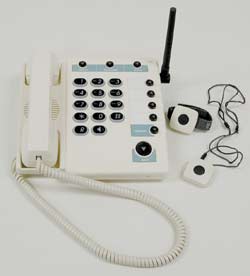
Electric cooperatives have been providing medical monitoring services to senior customers for nearly a decade. Many cooperatives, such as Maquoketa Valley Electric Cooperative and Cedar Valley Medical Monitoring, a holding company owned by five Iowa electric cooperatives, have enjoyed significant growth in customers and revenues. Cooperatives see medical monitoring as yet another service that can increase revenues, enhance customer loyalty and improve their standing within the communities they serve.
The credibility associated with cooperatives offering aging-in-place services such as medical monitoring is now well established. The Cooperative Response Center in Austin, Minnesota currently monitors over 8,000 emergency response units for electric cooperatives. Touchstone Energy has recently included medical monitoring service in its Advantage Program under the brand name Life Safety Monitoring™. Many rural seniors now depend on their cooperatives to help them remain independent while reducing their health care costs.
It is not difficult to understand why medical monitoring can be a successful program for cooperatives. With changes in Medicare and insurance reimbursement policies, the resources of home health care services are already taxed beyond their limits. Add to this the predicted growth of the senior population over the next decade, and you have all the ingredients of a major health care crisis. By offering medical monitoring, the electric cooperative steps to the plate with a cost effective alternative to expensive in-home or institutionalized health care.
Like any service, a successful medical monitoring program won’t just happen. Although start-up costs are low, a commitment of human and marketing resources are required to make the program grow. Jerri McCracken, Marketing Manager of Cedar Valley Medical Monitoring understood this from the beginning. From the program’s inception, Jerri knew she had to “get the word out” to the hospitals and home health care providers in her service area. Even with competing local hospital programs, Jerri effectively established credibility among health care providers as an affordable, reliable source of medical monitoring to seniors. As a result of her dedicated efforts, Jerri has built a profitable, revenue-producing program for Cedar Valley.
Patty Manual, Communications/Marketing Supervisor for Maquoketa Valley Electric Cooperative has also built a strong, revenue-producing program. Like Jerri, Patty concentrates on networking with hospitals and other healthcare providers. Understanding the needs of seniors in her service area, Patty has provided a program that can often reduce healthcare costs. Patty’s medical monitoring program also makes it possible for health care providers to focus limited resources on their more needy senior clients.
For those cooperatives with an established, credible presence in medical monitoring, the next step in home health technology has arrived. Expanding on the concept of monitoring through telecommunication technology, virtual home health visits are now possible between a home health care provider and a senior client. Using remote controlled radio frequency devices, the health care provider can monitor a senior’s blood pressure, blood oxygen level, pulse, and temperature from their desktop or notebook computer. The provider calls the client on the phone, asks them to turn on their television and then gives simple instructions on how to attach monitoring equipment. Through a camera placed on the television, the provider will be able to see the client. The client will also be able to see the provider on her television screen. Real-time audio between client and provider will occur over the telephone or cable access line.
The virtual home health care visit allows the provider to save both time and expense. The provider is still able to do routine checks on the client’s condition without costs incurred through travel. The cost and time savings will be particuarly noted in rural areas where extensive travel has been unavoidable.
Already beta-tested in Canada, virtual home health care technology will be field tested this spring by two electric cooperatives in the United States. By late 2002, it is anticipated that the technology will be available to those electric cooperatives already involved in successful medical monitoring programs.







